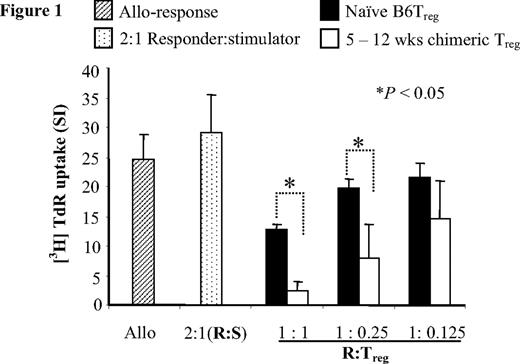Abstract
Abstract 2424
Poster Board II-401
We previously reported that CD8+TCR- facilitating cells (FC) induce the generation of chimeric regulatory T cells (Treg) in vivo. Transplantation of a mixture of CD8+/TCR- FC and hematopoietic stem cells (HSC) into ablated recipients results in chimerism and tolerance. Treg harvested from the spleen of chimeras (chimeric Treg) potently increase long-term donor chimerism in secondary NOD recipient mice. Here, we evaluated whether chimeric Treg enhance engraftment of hematopoietic stem cells (HSC) in an antigen-specific manner. To prepare mixed chimeras (B6 → NOD), NOD recipients were conditioned with 950 cGy TBI and transplanted with 10,000 B6 HSC and 1,000 NOD HSC plus 45,000 CD8+TCR- B6 FC. At 5 weeks, CD8-CD4+CD25bright chimeric Treg were sorted from spleens of the mixed chimeras (B6 → NOD). 100,000 chimeric Treg were then mixed with 10,000 B6 HSC (donor-specific) + 10,000 B10.BR HSC (third-party) and transplanted into conditioned NOD recipients in competitive repopulation assays. NOD mice given HSC plus nonchimeric naïve B6 Treg or HSC alone served as controls. Two of the four animals that received HSC alone engrafted and exhibited an average of 6.7% donor B6 chimerism at 30 days, 11.2% at 60 days, and 10.6% at 90 days. Three of five animals given HSC plus naïve B6 Treg engrafted with 21.3% donor B6 chimerism at 30 days, 28.8% at 60 days, and 28.9% at 90 days. In contrast, eight of nine recipients of HSC + chimeric Treg engrafted. These animals exhibited a significantly higher level of donor B6 chimerism, ranging from 56.3% at 30 days, 75.4% at 60 days to 85% at 90 days (P = 0.034). None of the recipients engrafted with the MHC-disparate third-party B10.BR HSC. We then assessed the suppressive function of chimeric Tregin vitro by using MLR suppressor cell assays. CD8-/CD4+/CD25bright Treg were sorted from chimeric spleens 5 wks to 12 wks after HSC + FC transplantation. As shown in the Figure 1, Treg from naïve B6 mice resulted in 1.9 fold; 1.3 fold and 1.1 fold inhibition of proliferation at 1:1, 1:0.25, 1:0.125 responder/Treg ratios (n = 3). In contrast, chimeric Treg potently suppressed T cell proliferation by 10.5 fold; 3.2 fold; and 1.7 fold at responder/Treg ratios of 1:1, 1:0.25, 1:0.125 (n = 4). Chimeric Treg significantly suppressed T cell proliferation at responder/Treg ratios of 1:1 and 1:0.25 compared with naïve B6 Treg (P < 0.05). NOD responder splenocytes remained hypoproliferative in response to B6 stimulator and chimeric Treg compared with stimulator plus B6 Treg, suggesting that chimeric Treg are significantly more potent than naïve B6 Treg in suppressing effector T cell proliferation in vitro. These data show that chimeric Treg enhance donor B6 HSC engraftment but not third-party B10.BR HSC, demonstrating that chimeric Treg function in vivo in an antigen-specific fashion. These data also show that the mechanism of FC function in vivo is associated with the establishment of an antigen-specific regulatory feedback loop.
Bozulic:Regenerex: Employment. Ildstad:Regenerex: Equity Ownership.
Author notes
Asterisk with author names denotes non-ASH members.


This feature is available to Subscribers Only
Sign In or Create an Account Close Modal